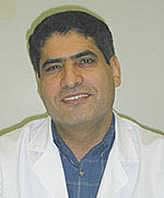Lutfi Abu-Elheiga, Ph.D.
Biochemistry & Molecular
Biology

Salih J. Wakil, Ph.D.
Biochemistry & Molecular
Biology

The role of acetyl-CoA carboxylasas in fatty acid metabolism and energy homeostasis
In a collaborative effort, Salih J.Waki and Lutfi Abu-Elheiga discovered the enzyme critical to the metabolic pathways that govern the body's ability to burn fat.
Malonyl-Coenzyme A, generated by acetyl-CoA carboxylase reaction, is a key intermediate in the metabolism of fatty acids. It is the substrate for the synthesis of long-chain fatty acids by the fatty acid synthase and it regulates the mitochondrial oxidation of fatty acids and energy homeostasis. To perform these two vital, but opposite metabolic functions, animals, including humans, were evolved with two acetyl-CoA carboxylases, ACC1 and ACC2, that are encoded by separate genes and display distinct tissue expression and regulation. ACC1 is predominantly expressed in lipogenic tissues, liver and adipose, whereas ACC2 is highly expressed in heart and muscle, tissues that are dependent on energy production and utilization. The levels and activities of ACC1 and ACC2 are highly affected by the dietary, hormonal, and physical states of the animals. The amino acid sequences of human ACC1 (M r~265,000)and ACC2 (M r~280,000), predicted from their cDNA sequences, show about 70% similarity. However, ACC2 has an additional 140 amino acids located at the N-terminus of the molecule and functions as a lead peptide that targets ACC2 to cellular membranes. Indeed, we demonstrated that ACC2 is associated with the mitochondrial membranes, whereas ACC1, lacking the N-terminal lead sequence, is located in the cytosol. To understand the roles of ACC1 and ACC2 in energy metabolism, we made targeted deletions of the genes in mice. Acc1 -/- mutant mice were embryonically lethal, possibly due to lack of fatty acid synthesis needed for biomembrane synthesis. Acc2 -/- mutant mice bred normally and had normal life spans. Acc2 -/- mice fed normal diets accumulated significantly less fat in their livers and adipose than the wild-type mice. Overnight fasting resulted in a 5-fold increase in ketone bodies production, indicating higher fatty acid oxidation. ACC1 and fatty acid synthase activities and malonyl-CoA contents of the livers of the Acc2 -/- and ACC2 +/+ mice were the same, indicating that fatty acid synthesis is unperturbed. Yet, the malonyl-CoA was not available for the inhibition of the mitochondrial carnitine palmitoyl-CoA shuttle system; hence, fatty acid oxidation was relatively high. Also, it indicated that the ACC1-generated malonyl-CoA occupies distinct compartments of the liver cell than that generated by ACC2. The absence of ACC2 in the mutant mice resulted in 10- and 30-fold lower malonyl-CoA contents of heart and muscle, respectively. Fatty acid oxidation in the Acc2 -/- soleus muscles was 30% higher than the wild-type muscle. The addition of insulin did not affect fatty acid oxidation in the Acc2 -/- soleus muscle, but as expected, it did reduce fatty acid oxidation by 50% in the wild-type soleus muscle compared to that of the mutant muscle. Isproterenol, an analog of glucagon, had little effect on fatty acid oxidation in the muscle of the Acc2 -/- mice, but caused a 50% increase in fatty oxidation in the wild-type soleus muscle. The higher fatty acid oxidation in the mutant mice resulted in a 50% reduction of fat storage in the adipose tissue, compared to that of the wild-type mice. This is a state humans try to achieve by physical exercise. The decrease in the size of adipose in Acc2 -/- mice resulted in a 35% decrease in plasma leptin, compared to that of the wild-type. In comparison, the Acc2 -/- mice had relatively higher appetites, consuming 20 to 30% more food than the wild-type mice, yet weighed 10-15% less. These results are valuable to our understanding and control of fatty acid metabolism and energy homeostasis in normal, diabetic, and obese animals. They also highlight the acetyl-CoA carboxylase 2 as a potential target for controlling body weight.
Dr. Wakil and Abu-Elheiga’s nomination was based on the following publications:
Abu-Elheiga L, Brinkley WR, Zhong L, Chirala SS, Woldegiorgis G, Wakil SJ."
The subcellular localization of acetyl-CoA carboxylase 2. ". Proc Natl Acad
Sci U S A. 2000 Feb 15;97(4):1444-9.
Abu-Elheiga L, Matzuk MM, Abo-Hashema KA, Wakil SJ. "
Continuous fatty acid oxidation and reduced fat storage in mice lacking acetyl-CoA
carboxylase 2 ".Science. 2001 Mar 30;291(5513):2613-6.
